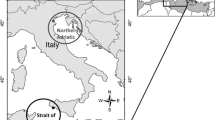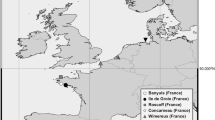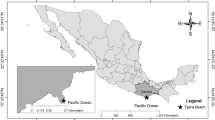Abstract
Two distinct modes of development in the common polychaete Scoloplos armiger (O. F. Müller, 1776) occur in the North Sea region: holobenthic development in egg cocoons and pelagic larvae hatching from suspended eggs. In the northern Wadden Sea near the island of Sylt, we observed that egg cocoons are produced intertidally while pelagic larvae originate from the adjacent subtidal zone. A previous genetic comparison between these subtidal and intertidal populations revealed distinct gene pools, suggesting that reproductive differences are not phenotypic but heritable. In this study, crossbreeding experiments show that intertidal and subtidal populations are reproductively isolated. Couples with males and females from different habitats had no offspring. Production of egg cocoons is determined by female origin from the intertidal zone. Pelagic larvae occurred only in couples with subtidal females and subtidal males. Intertidal males have spermatozoa with heads twice as long as those from subtidal males and a significantly shorter flagellum. We suspect that deviating sperm morphology may cause the reproductive breakdown at the fertilization stage. Juveniles hatching from cocoons have shorter anal cirri compared to juveniles that metamorphosed from pelagic larvae. We conclude there to be two sympatric sibling species in S. armiger: 'type I' in intertidal areas, which have egg cocoons, no pelagic larvae, elongated sperm heads, shortened sperm flagella and anal cirri; and a subtidal 'type S', lacking egg cocoons but with pelagic larvae, short sperm heads, long sperm flagella and anal cirri.





Similar content being viewed by others
References
Anderson DT (1959) The embryology of the polychaete Scoloplos armiger. Q J Microsc Sci 100: 69–166
Annenkova NP (1938) Polikheti severnoi chasti iaponskogo moria i ikh fatsial'noe i vertikal'noe raspredelenie—Polychaeta of the North Japan Sea and their horizontal and vertical distribution. Gidrobiol eksped 1934 g. Iaponskoje More. Trudy 1: 81–230
Armonies W (1994) Drifting meio- and macrobenthic invertebrates on tidal flats in Königshafen: a review. Helgol Meeresunters 48: 299–320
Armonies W (1998) Driftendes Benthos im Wattenmeer: Spielball der Gezeitenströmungen? In: Gätje C, Reise K (eds) Ökosystem Wattenmeer: Austausch-, Transport- und Stoffumwandungsprozesse. Springer, Berlin Heidelberg New York, pp 473–498
Banse K (1955) Über das Verhalten von meroplanktischen Larven in geschichtetem Wasser. Kiel Meeresforsch 11: 188–200
Beesley PL, Ross GJB, Glasby CJ (2000) Polychaetes and allies: the southern synthesis. Fauna of Australia, vol 4A. Polychaeta, Myzostomida, Pogonophora, Echiura, Sipuncula. CSIRO, Melbourne
Beukema JJ (1976) Biomass and species richness of the macro-benthic animals living on the tidal flats of the Dutch Wadden Sea. Neth J Sea Res 10: 236–261
Blake JA (1980) The larval development of Polychaeta from the northern California coast IV. Leitoscoloplos pugettensis and Scoloplos acmeceps (Familiy Orbiniidae). Ophelia 19: 1–18
Bosselmann A (1991) Recruitment and postlarval growth of some macrozoobenthos species in the German Bight. Meeresforsch 33: 141–158
Cabioch L, L'Hardy JP, Rullier F (1968) Inventaire de la Faune marine de Roscoff. Annélides. Trav Stat Biol Roscoff 17: 1–95
Chapman G (1965) The egg cocoons of Scoloplos armiger O. F. Müller. Biol Bull 128: 189–197
De Groot GJ (1907) Aaanteekenigen over de ontwikkelung van Scoloplos armiger. Dissertation, University of Leiden
Dobzhansky T, Ayala F, Stebbins GL, Valentine JW (1977) Evolution. Freeman, San Francisco
Eckelbarger KJ, Grassle JP (1987) Spermatogenesis, sperm storage and comparative sperm morphology in nine species of Capitella, Capitomastus and Capitellides (Polychaeta: Capitellidae). Mar Biol 95: 415–429
Franzén Å (1956) On spermiogenesis, morphology of the spermatozoon, and biology of fertilization among invertebrates. Zool Bidr Från Uppsala 31: 355–482
Frith DW, Tantanasiriwong R, Bhatia O (1976) Zonation of macrofauna on a mangrove shore, Phuket Island. Res Bull Phuket Mar Biol Cent 10: 1–37
Gätje C, Reise K (1998) Ökosystem Wattenmeer, Austausch-, Transport- und Stoffumwandlungsprozesse. Springer, Berlin Heidelberg New York
Gibbs PE (1968) Observations on the population of Scoloplos armiger at Whitstable. J Mar Biol Assoc UK 48: 225–254
Giere O (1968) Die Fluktuationen des marinen Zooplanktons im Elbe-Aestuar. Arch Hydrobiol [Suppl] 3/4: 379–546
Grassle JP, Grassle JF (1976) Sibling species in the marine pollution indicator Capitella (Polychaeta). Science 192: 567–569
Hartmann-Schröder G (1996) Polychaeta. In: Dahl F, Schumann H (eds) Die Tierwelt Deutschlands und angrenzender Meeresteile nach ihren Merkmalen und ihrer Lebensweise, 2nd edn. Fischer, Stuttgart
Holte B, Gulliksen B (1998) Common macrofauna dominant species in the sediments of some north Norwegian and Svalbard glacial fjords. Polar Biol 19: 375–382
Hornell J (1891) Report on the polychaetous annelids of the L.M.B.C. district. Trans Liverpool Biol Soc 5: 223
Jamieson BGM, Rouse GW (1989) The spermatozoa of the Polychaeta (Annelida): an ultrastructural review. Biol Rev 64: 93–157
Knowlton N (1993) Sibling species in the sea. Annu Rev Ecol Syst 24: 89–216
Kruse I, Reusch TBH, Schneider MV (2003) Sibling species or poecilogony in the polychaete Scoloplos armiger? Mar Biol 142: 937–947
Mau W (1882) Über Scoloplos armiger O. F. Müller. Z Wiss Zool (Leipz) 36: 389–432
Mayr E (1942) Systematics and the origin of species. Columbia University Press, New York
Mayr E (1963) Animal species and evolution. Harvard University Press, Cambridge
McDonald JH, Seed R, Koehn RK (1991) Allozyme and morphometric characters of three species of Mytilus in the Northern and Southern hemispheres. Mar Biol 111: 323–335
Olive PJ (1983) Annelida—Polychaeta. In: Adiyodi KG, Adiyodi RG (eds) Reproductive biology of invertebrates, vol 2. Spermatogenesis and sperm function. Wiley, Chichester
Olenin S, Schiedek D (1996) Is the polychaete Scoloplos armiger a biological marker of saline water inflows into subhalocline areas of the Baltic proper? In: Abstracts of the Baltic marine science conference, Rønne, Bornholm, p 3
Pfannenstiel H-D, Grünig C (1990) Spermatogenesis and sperm ultrastructure in the polychaete genus Ophryotrocha (Dorvilleidae). Helgol Meeresunters 44: 159–171
Pfannenstiel H-D, Grünig C, Lücht J (1987) Gametogenesis and reproduction in nereidid sibling species (Platynereis dumerilii and P. massiliensis). Biol Soc Wash Bull 7: 272–279
Plate S, Husemann E (1991) An alternative mode of larval development in Scoloplos armiger (O. F. Müller, 1776) (Polychaeta, Orbiniidae). Helgol Meeresunters 45: 487–492
Rasmussen E (1973) Systematics and ecology of the Isefjord marine fauna (Denmark). Ophelia 11: 1–507
Reise K (1979) Spatial configurations generated by motile benthic polychaetes. Helgol Meeresunters 32: 55–72
Rice S, Simon J (1980) Intraspecific variation in the pollution indicator polychaete Polydora ligni (Spionidae). Ophelia 19: 79–115
Ridley M (1996) Evolution. Blackwell Scientific, Boston
Sach G (1975) Zur Fortpflanzung des Polychaeten Anaitides mucosa. Mar Biol 31: 157–160
Schultze MS (1855) Über die Entwicklung von Arenicola piscatorum nebst Bemerkungen über die Entwicklung anderer Kiemenwürmer. Abh Naturf Ges Halle 3: 211
Stripp K (1969) Die Assoziationen des Benthos in der Helgoländer Bucht. Veröff Inst Meeresforsch Bremerhaven 12: 95–141
Sveshnikov VA (1960) Pelagic larvae of some polychaeta in the White Sea. Zool Zh 39: 343–355
Thamdrup HM (1935) Beiträge zur Ökologie der Wattenfauna auf experimenteller Grundlage. Medd Danm Fisk Havunders (Ser Fiskeri) 10: 1–125
Weber K (1992) Fortpflanzung, Populationsdynamik und Lebensweise von Scoloplos armiger. Diploma thesis, Christian-Albrechts-Universität zu Kiel, Kiel
Wesenberg-Lund E (1950) The polychaeta of West Greenland. Medd Grönland 151: 1–171
Ziegelmeier E (1978) Macrobenthos investigations in the eastern part of the German bight from 1950 to 1974. Rapp P-v Réun Cons int Explor Mer 172: 432–444
Acknowledgements
We wish to thank everyone from the Wadden Sea Station Sylt involved in this study, especially the crew of the ship "Mya", Niels Kruse, Peter Elvert and Timo Wieck, for excellent team work during the sampling of the subtidal habitat. Hanne Halliger ran the SEM and prepared the samples for it. This study was financially supported by the German Federal Ministry of Education and Research (BMBF) under grant 03F0179A and by the Alfred-Wegener-Institut fuer Polar- und Meeresforschung (AWI). All experiments were conducted in agreement with German law.
Author information
Authors and Affiliations
Corresponding author
Additional information
Communicated by O. Kinne, Oldendorf/Luhe
Rights and permissions
About this article
Cite this article
Kruse, I., Reise, K. Reproductive isolation between intertidal and subtidal Scoloplos armiger (Polychaeta, Orbiniidae) indicates sibling species in the North Sea. Marine Biology 143, 511–517 (2003). https://doi.org/10.1007/s00227-003-1112-x
Received:
Accepted:
Published:
Issue Date:
DOI: https://doi.org/10.1007/s00227-003-1112-x




